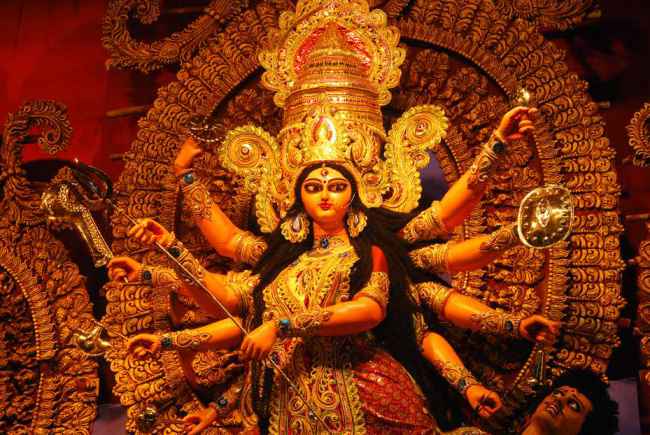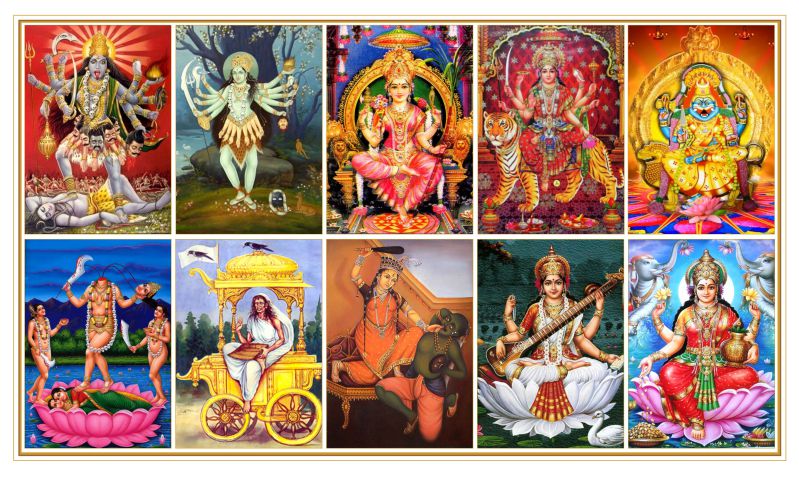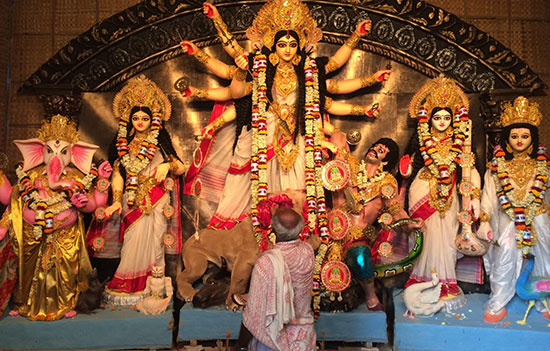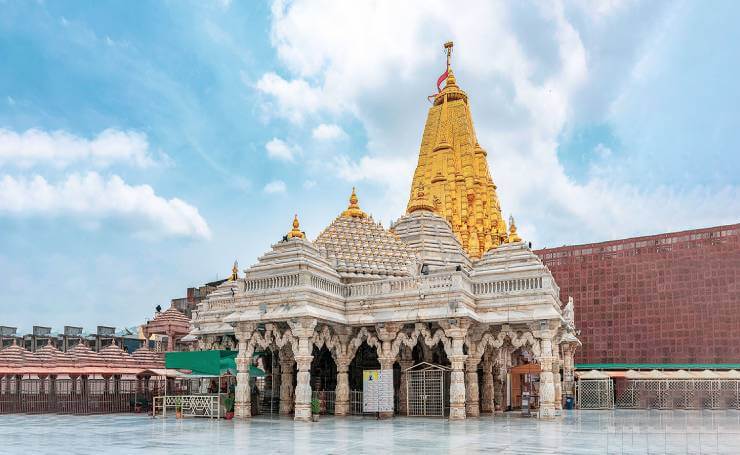About Lord Durga

Durga, commonly referred to as "Maa Durga" or simply "Durga," is a revered goddess in Hinduism, embodying divine feminine power. Her name, translating to "the inaccessible" or "the invincible," reflects her formidable nature. Widely venerated across India, she is particularly celebrated during the grand festival of Durga Puja. Durga is depicted as a radiant goddess with multiple arms, each wielding distinct weapons and symbols, often seated atop a lion or tiger, symbolizing her strength and fearlessness. She personifies both nurturing and protective qualities, as well as the capacity to defeat malevolent forces. Durga is associated with the triumph of good over evil, invoked for protection, and revered for her resilience. Her origin stories, including her creation to vanquish the demon Mahishasura, are recounted in various Hindu texts. The annual Durga Puja festival is a central occasion for her worship, marked by elaborate idols and exuberant celebrations. Durga's symbolism extends to the multifaceted aspects of feminine energy, embodying both nurturing and fierce qualities, making her a symbol of strength, protection, and hope for her devotees.
What is special about Durga?
Durga holds a special place in Hinduism for several significant reasons:
Goddess of Power: Durga is revered as a symbol of divine feminine energy and strength. She embodies the powerful aspect of the feminine, highlighting the idea that women possess immense inner strength and resilience.
Victory Over Evil: Durga is often depicted as a warrior goddess who battles and triumphs over various demons and negative forces. Her stories and imagery symbolize the ultimate victory of righteousness over evil, making her a powerful source of inspiration and hope.
Diverse Forms: Durga's many forms and manifestations represent different aspects of life and the universe. Whether as the nurturing mother, the fierce warrior, or the serene goddess, she reflects the multifaceted roles and qualities of women and the cosmos.
Durga Puja Festival: The annual Durga Puja festival is one of the most significant Hindu celebrations. It is marked by elaborate rituals, cultural performances, and grand processions. During this festival, the worship of Durga is at its zenith, and it serves as a unifying cultural event for communities and regions.
Protection and Guidance: Devotees turn to Durga for protection and guidance. She is believed to shield her followers from harm and help them navigate life's challenges, making her a beloved and cherished deity in Hinduism.
Cultural Significance: Durga Puja is not limited to religious significance; it also carries cultural and artistic importance. Elaborate sculptures and decorations, along with music and dance performances, are integral to the celebration.
Feminine Empowerment: Durga's symbolism extends beyond religious contexts. She is often seen as an icon of feminine empowerment, encouraging women to embrace their inner strength and assert their rights in society.
In summary, Durga is special for her role as a symbol of strength, her ability to conquer evil, her diverse forms, the grand celebrations during Durga Puja, her protective and guiding nature, and her broader significance in promoting feminine empowerment and resilience. Her worship and stories have a profound impact on the spiritual and cultural landscape of India and among Hindus worldwide.
Why is Durga so powerful?

Durga's extraordinary power in Hindu mythology stems from several significant factors. Firstly, her divine origin is rooted in the collective energies and essence of the gods (Devas), making her inherently potent and formidable. Her most celebrated achievement is the defeat of the nearly invincible demon Mahishasura, symbolizing the unequivocal victory of good over evil. Durga's depiction with multiple arms, each wielding different weapons and symbols, signifies her ability to simultaneously harness various powers, giving her versatility and immense strength to overcome adversity. Her association with riding a lion or tiger underscores her fearlessness and unwavering determination in confronting and conquering malevolent forces, making her a symbol of courage and valor.
However, her power goes beyond her martial prowess. Durga is equally revered for her protective and nurturing qualities, serving as a beacon of guidance and support for her devotees. She is trusted to shield them from harm and provide wisdom during challenging times. Furthermore, as a representation of divine feminine energy, she embodies the inherent strength and resilience of women. Her role in maintaining the cosmic order by battling chaos and evil is considered pivotal, ensuring balance and harmony in the universe. Durga's influence extends to the cultural realm, as her worship unites people of various backgrounds during the grand celebration of Durga Puja, emphasizing her remarkable ability to bring communities together. In summary, Durga's unparalleled power emanates from her divine origin, her triumph over formidable adversaries, her versatility, her protective and nurturing attributes, and her role as a symbol of courage, strength, and unity.
Why does Durga have 3 eyes?
Durga, like many Hindu deities, is often depicted with three eyes, and the symbolism behind this feature is rich and significant. The three eyes of Durga represent various aspects of her divine nature:
The Left Eye (Moon): Durga's left eye, associated with the moon, symbolizes her calming and nurturing qualities. The moon is often seen as a soothing and gentle celestial body, and it represents the feminine energy and motherly aspect of the goddess. Durga's left eye is a reminder of her protective and caring nature, watching over her devotees and providing them with a sense of comfort and assurance.
The Right Eye (Sun): Durga's right eye, associated with the sun, represents her fiery and fierce nature. The sun is a powerful and radiant force, signifying strength and determination. Durga's right eye signifies her ability to confront and vanquish evil forces and her unwavering commitment to upholding righteousness. It represents her warrior aspect in the battles against demons and negative influences.
The Third Eye (Inner Wisdom): Durga's third eye, often depicted on her forehead, represents her inner wisdom, insight, and spiritual awareness. It signifies her ability to see beyond the physical and material world and to perceive deeper truths. The third eye is associated with higher consciousness and intuition, reflecting Durga's profound knowledge and divine insight.
In Hinduism, the concept of the third eye is not limited to Durga but is a recurring motif among various deities and is often linked to spiritual awakening and enlightenment. Durga's three eyes collectively symbolize her balance of nurturing and protective qualities, her strength and determination, and her profound spiritual wisdom, making her a multifaceted and powerful goddess.
Who is Goddess Durga, and what is her significance in Hinduism?
Goddess Durga, also known as Maa Durga, is a prominent and revered deity in Hinduism. She holds great significance and plays multiple roles within the Hindu pantheon. Here is an overview of Goddess Durga and her significance in Hinduism:
Identity and Appearance:
Durga is a goddess known for her extraordinary power, strength, and courage. She is often depicted with multiple arms, typically ten, each holding a different weapon or symbol. Her image conveys both her nurturing and protective qualities, as well as her capacity to vanquish evil forces. Durga is usually portrayed riding a lion or tiger, symbolizing her fearlessness and dominance over the animal kingdom.
Significance in Hinduism:
Symbol of Divine Feminine Energy: Durga is considered the embodiment of Shakti, the divine feminine energy that represents the creative and destructive aspects of the cosmos. She showcases the immense strength and resilience found in women and is a symbol of the feminine power that sustains the universe.
Victory Over Evil: Durga is particularly celebrated for her battles against demons and negative forces. Her most famous feat is the defeat of the demon Mahishasura, who was almost invincible. This victory symbolizes the triumph of righteousness over tyranny and evil, making Durga a beacon of hope and the guardian of moral order.
Protector and Guide: Devotees turn to Durga for protection and guidance. She is believed to shield her followers from harm and provide the wisdom needed to navigate the challenges of life. Many seek her blessings for strength and courage in their endeavors.
Durga Puja Festival: The annual festival of Durga Puja, celebrated with grandeur in India, is dedicated to honoring and worshipping Goddess Durga. During this time, beautifully crafted idols of the goddess are adorned and worshipped, and communities come together to celebrate cultural and religious traditions.
Cultural and Social Unity: Durga Puja transcends religious boundaries and serves as a unifying cultural event. It brings people of various backgrounds and regions together to participate in the festivities, emphasizing the goddess's role in fostering unity and social cohesion.
Feminine Empowerment: Durga's worship and symbolism extend beyond religious contexts. She serves as an icon of feminine empowerment, encouraging women to embrace their inner strength, assert their rights, and overcome challenges.
In summary, Goddess Durga is a multifaceted and powerful deity in Hinduism. Her significance lies in her representation of divine feminine energy, her victories over evil, her protective and guiding nature, her role in cultural celebrations, and her ability to inspire and empower individuals, especially women, in their life journeys. Durga's worship is a testament to the enduring and dynamic nature of Hindu spirituality and culture.
The different names and forms of Goddess Durga in Hindu mythology

Goddess Durga is known by various names and forms in Hindu mythology, reflecting her diverse attributes and manifestations. Here are some of the different names and forms of Goddess Durga:
Parvati: Parvati is one of the primary forms of Durga. She is the gentle and nurturing aspect of the goddess and is often depicted as the consort of Lord Shiva.
Mahakali: Mahakali is one of the fiercest forms of Durga. She is often depicted with a dark complexion, symbolizing her destructive power.
Mahalakshmi: Mahalakshmi is the goddess of wealth and prosperity. She is often associated with Durga, representing her benevolent and nurturing side.
Mahasaraswati: Mahasaraswati is the goddess of knowledge, music, and the arts. She is often considered another aspect of Durga, representing her wisdom and creative qualities.
Chandika: Chandika is a form of Durga associated with fierce and destructive aspects. She is often invoked for protection against malevolent forces.
Annapurna: Annapurna is the goddess of food and nourishment. She symbolizes the importance of sustenance and is a nurturing aspect of Durga.
Bhadrakali: Bhadrakali is a powerful and fierce form of Durga. She is often depicted with a dark complexion and multiple arms, ready to combat evil forces.
Shailaputri: Shailaputri, meaning "Daughter of the Mountain," is one of the nine forms of Durga worshipped during Navaratri. She is associated with the earth and nature.
Brahmacharini: Brahmacharini is another form of Durga during Navaratri. She represents the pursuit of knowledge, meditation, and spirituality.
Chandraghanta: Chandraghanta is a form of Durga known for her courage and grace. She is often depicted with a half-moon on her forehead.
Kushmanda: Kushmanda is the goddess who created the universe with her divine smile. She is associated with creativity and the life-giving force.
Skandamata: Skandamata is the mother of Lord Skanda (Kartikeya), the god of war. She represents motherly love and protection.
Katyayani: Katyayani is a fierce form of Durga who is associated with courage and valor. She is often worshipped for strength and protection.
Kalratri: Kalratri is a dark and fearsome form of Durga, often depicted with a fierce expression and wielding destructive weapons.
Maha Gauri: Maha Gauri is a serene and peaceful form of Durga. She represents purity and devotion.
These are just a few of the many names and forms of Goddess Durga in Hindu mythology. The diversity of her manifestations underscores her multifaceted nature and her ability to adapt to various roles and qualities within the Hindu pantheon.
The story of Durga's battle with the demon Mahishasura and its symbolism?
The story of Durga's battle with the demon Mahishasura is a significant and symbolic narrative in Hindu mythology. It tells of a mighty demon, Mahishasura, who, through a boon from Lord Brahma, gained the ability to change his form at will, rendering him nearly invincible. His tyranny and cruelty led to the Devas, the gods, being unable to defeat him. In response, the Devas combined their divine energies to create Durga, a powerful and radiant goddess with ten arms who rode into battle atop a lion. A fierce and prolonged conflict ensued, with Mahishasura transforming into various fearsome creatures. However, Durga remained unyielding and ultimately defeated the demon by piercing him with a trident.
The symbolism in this story is profound. It represents the victory of good over evil, illustrating that righteousness and moral order can triumph over malevolence and arrogance, even when faced with the most formidable adversary. Moreover, it emphasizes the empowerment of the divine feminine, as Durga personifies the strength, resilience, and courage found in women. The story also underscores the significance of unity in diversity, as Durga was created from the collective energies of multiple gods, highlighting the power of cooperation. Additionally, it conveys the message of adaptability and creativity in countering life's ever-changing challenges, along with the importance of courage and determination in the face of adversity. This timeless tale remains a revered and cherished part of Hindu mythology, imparting profound spiritual and moral lessons.
What is the importance of Durga Puja, and how is it celebrated in various parts of India?

Durga Puja is one of the most significant and widely celebrated Hindu festivals in India, particularly in the eastern states of West Bengal, Assam, and Tripura, as well as other regions. Its importance is multi-faceted, and the festival is marked by grand celebrations and cultural significance. Here is an overview of the importance of Durga Puja and how it is celebrated in various parts of India:
Importance of Durga Puja:
Religious Significance: Durga Puja is dedicated to the worship of Goddess Durga, who symbolizes the victory of good over evil. The festival commemorates her defeat of the demon Mahishasura, signifying the triumph of righteousness and the protective and nurturing aspects of the divine feminine.
Cultural Significance: Durga Puja is not limited to religious observance; it also holds immense cultural importance. It is a time for artistic expression, creative decorations, music, dance, and cultural performances. The festival showcases the rich cultural heritage of the regions where it is celebrated.
Community Bonding: Durga Puja is a time when communities come together to organize and celebrate the festival. It fosters a sense of unity, social cohesion, and solidarity among people of diverse backgrounds.
Celebrations in Various Parts of India:
West Bengal: Durga Puja in West Bengal is the most famous and elaborate celebration of the festival. The entire state comes alive with beautifully crafted pandals (temporary structures) that house idols of the goddess. The pandals are often thematic and artistic, showcasing various aspects of culture and society. The festival is marked by elaborate rituals, cultural performances, processions, and immersion of the idols in rivers.
Assam: In Assam, Durga Puja, also known as Navaratri, is celebrated with great enthusiasm. The festival includes dance forms like Bihu and Sattriya, and the idols are often made of clay. In Assam, the immersion of the idols is not as common, and the festival is a time for cultural programs and traditional celebrations.
Tripura: Durga Puja is a major festival in Tripura, and it holds a unique significance in the state. The festival is celebrated with grand processions and cultural performances, and it is an important part of the state's cultural identity.
Other Regions: Durga Puja is also celebrated in other parts of India, with varying degrees of grandeur. In Delhi, Mumbai, and other urban centers, the Bengali community and other devotees come together to celebrate the festival. The rituals and customs are similar to those in West Bengal, including artistic pandals and cultural performances.
In summary, Durga Puja is an important festival in India, celebrated with deep religious and cultural significance. It is a time for communities to unite, showcase their creativity, and pay homage to the powerful goddess Durga. The festival's grandeur and diversity make it a vibrant and cherished part of India's cultural tapestry.
The key symbols and attributes associated with Goddess Durga?
Goddess Durga is associated with a variety of symbols and attributes that represent her diverse qualities and manifestations. Here are some key symbols and attributes associated with Goddess Durga:
Multiple Arms: Durga is typically depicted with multiple arms, most commonly ten, each holding different weapons or symbols. These arms symbolize her ability to simultaneously wield various powers and attributes.
Lion or Tiger: Durga is often depicted riding a lion or tiger, which represents her fearlessness, power, and dominance over the animal kingdom.
Trident (Trishula): The trident in Durga's hand symbolizes her power to destroy evil and ignorance. It represents the three fundamental qualities of nature: sattva (goodness), rajas (passion), and tamas (ignorance).
Sword (Khadga): The sword is a weapon of Durga, signifying her ability to cut through illusions and falsehood, revealing the truth.
Spear (Shula): The spear in Durga's hand represents her ability to pierce through negativity and obstacles, allowing her devotees to move forward.
Bow and Arrow: Durga sometimes holds a bow and arrow, symbolizing her precision and focus in overcoming challenges.
Conch Shell (Shankha): The conch shell represents the primordial sound, symbolizing the creation of the universe and the beginning of existence.
Lotus (Padma): The lotus symbolizes purity and enlightenment, and it signifies Durga's transcendental and divine nature.
Rosary (Mala): The rosary represents concentration and spiritual discipline, emphasizing Durga's meditative and contemplative aspects.
Third Eye: Durga is often depicted with a third eye on her forehead, symbolizing her inner wisdom, perception of deeper truths, and higher consciousness.
Diverse Forms: Durga has various forms and manifestations, each representing different aspects of her nature. These forms can be benevolent, nurturing, or fierce, emphasizing her multifaceted character.
Radiant Aura: Durga is depicted as radiantly beautiful, signifying her divine presence and grace.
Demon Defeated: In some depictions, Durga is shown with her foot on the chest of a defeated demon, symbolizing her victory over evil and injustice.
Red Sari: Durga is often clothed in a red sari, symbolizing her strength and the bloodshed required to defeat demons and protect her devotees.
Chakra (Wheel): Durga may hold a chakra, representing her ability to dispel ignorance and guide her devotees on the path of righteousness.
These symbols and attributes collectively emphasize Durga's diverse qualities, from her protective and nurturing nature to her formidable power and her role as a guardian against evil. They showcase her significance in Hindu mythology and the reverence with which she is worshipped by millions of devotees.
What are some of the major temples dedicated to Goddess Durga in India and around the world?

India and various parts of the world have several major temples dedicated to Goddess Durga, reflecting the widespread reverence for this deity. Here are some of the notable temples dedicated to Goddess Durga:
India:
Dakshineswar Kali Temple, Kolkata, West Bengal: This iconic temple, located on the banks of the Hooghly River, is dedicated to Goddess Kali, a fierce form of Durga. It is famous for its association with the mystic Ramakrishna Paramahamsa.
Kamakhya Temple, Guwahati, Assam: The Kamakhya Temple is one of the most revered Shakti Peethas (holy shrines dedicated to the goddess) in India. It is dedicated to Goddess Kamakhya and is known for its unique rituals and traditions.
Vaishno Devi Temple, Katra, Jammu and Kashmir: Located in the Trikuta Mountains, this temple is dedicated to Goddess Vaishno Devi, another form of Durga. It is one of the most visited pilgrimage sites in India.
Amba Mata Temple, Gujarat: Situated in the Aravalli Range, this temple is dedicated to Goddess Amba, a form of Durga. It is renowned for its scenic location and annual Navaratri celebrations.
Chamunda Devi Temple, Himachal Pradesh: This temple in Kangra is dedicated to Goddess Chamunda, another form of Durga. It is known for its unique architectural style and stunning views of the Himalayas.
Maa Chintpurni Temple, Himachal Pradesh: This temple is dedicated to Goddess Chintpurni, a form of Durga, and is believed to fulfill the wishes of devotees.
Kalighat Kali Temple, Kolkata, West Bengal: Kalighat Temple is one of the most revered Kali temples in Kolkata, dedicated to Goddess Kali. It is a significant pilgrimage site for devotees.
Around the World:
Pashupatinath Temple, Kathmandu, Nepal: This temple, dedicated to Lord Shiva, also houses a shrine to Goddess Durga. It is a prominent religious site for both Hindus and Buddhists in Nepal.
Durga Temple, Varanasi, Nepal: Located in the ancient city of Varanasi in Nepal, this temple is dedicated to Goddess Durga and is known for its religious and cultural importance.
Sri Mariamman Temple, Singapore: This South Indian Hindu temple, dedicated to Goddess Mariamman (a form of Durga), is a significant place of worship for the Tamil community in Singapore.
Durga Temple, Aihole, Karnataka: This ancient temple, dating back to the 7th century, is dedicated to Goddess Durga and is known for its historical and architectural significance.
These are just a few of the major temples dedicated to Goddess Durga in India and around the world. Each of these temples reflects the diverse forms and regional significance of the goddess in Hindu culture and traditions.
In what ways does the festival of Navaratri connect with the worship of Goddess Durga, and what are its cultural and spiritual implications?
The festival of Navaratri is intrinsically linked to the worship of Goddess Durga and carries profound cultural and spiritual implications in Hinduism. It spans nine nights, each dedicated to one of the nine forms of the divine feminine, including various incarnations of Goddess Durga, emphasizing her multifaceted nature. The culmination of Navaratri with Dussehra, or Vijayadashami, commemorates Goddess Durga's victory over the demon Mahishasura, symbolizing the eternal triumph of good over evil and highlighting her protective and nurturing attributes.
Navaratri is more than a religious observance; it's a culturally vibrant festival celebrated with music, dance, and elaborate decorations. In Gujarat, the festival comes alive with traditional Garba and Dandiya dances, while South India showcases intricate kolam (rangoli) designs. These cultural expressions foster community unity and regional tradition preservation, transcending geographical and linguistic boundaries.
Many devotees observe fasting during Navaratri, both as a form of physical purification and a means of seeking spiritual renewal. Fasting encourages self-discipline and offers prayers to the goddess for personal well-being and inner strength.
Navaratri also serves as a reminder of the importance of respecting women. As a celebration of the divine feminine energy embodied by Goddess Durga, it promotes gender equality, emphasizing the empowerment and protection of women in society.
The festival's spiritual significance lies in the removal of negative energies and obstacles. Devotees seek to purify their minds and homes during this time, inviting positivity and prosperity.
Navaratri is a time of devotion and surrender to the divine, where devotees express their love, faith, and trust in Goddess Durga. It's a period of seeking her guidance and blessings to navigate life's challenges and to spiritually grow and transform. In essence, Navaratri encapsulates a multifaceted celebration, unifying culture and spirituality, and promoting values such as unity, gender equality, and personal transformation.
Conclusion:
In conclusion, the worship of Goddess Durga holds a special place in Hinduism, celebrating the divine feminine energy and its multifaceted nature. She represents the ultimate source of power, strength, and protection. The story of her battle with the demon Mahishasura symbolizes the victory of good over evil and serves as an inspiration for courage and determination in the face of adversity. The festival of Navaratri, dedicated to Goddess Durga, unites people from diverse backgrounds, promoting cultural expression, gender equality, and spiritual renewal. The temples dedicated to Goddess Durga in India and around the world stand as a testament to her enduring significance. With her rich symbolism and attributes, Durga continues to be a symbol of hope, empowerment, and divine grace for millions of devotees.


